Find out where to go in Italy without a car, stop and strip yourself of modernity, the hustle and bustle of engines and above all the city smog. It is a way of traveling, but also a lifestyle that makes the traveler and his host happy because it embraces the philosophy of "time for myself" in a world where time seems to pass faster and faster.
Haste, as we know, makes you lose moments that could instead be important memories, especially when you find yourself surrounded by the beauty of unknown places. Let's venture on this journey to rediscover 5 of the best destinations in Italy, where to go without a car, guided by patience and the simplicity of the journey.

Where to go in Italy without a car and why

Traveling by car is certainly convenient and fast, but you will soon find out that even with planes, trains and buses you can easily discover wonderful corners of Italy. When you are finally walking through places full of history and traditions, you will have the opportunity to harmonize with the environment around you, to follow its rhythms and to grasp its essence.
While traveling in Italy without a car you will be amazed by new details that you have never considered. You will have the feeling of being an integral part of the community, losing the identity of the tourist, starting to experience an authentic journey.
Italy is the ideal destination to rediscover on foot, along ancient roads, old trade routes, forgotten villages still vivid and rich in historical testimonies. An intelligent and eco-sustainable approach that allows you to discover lesser-known wonders, far from the usual tourist destinations.
5. Where to go in Italy without a car: Bomarzo, the mistery village
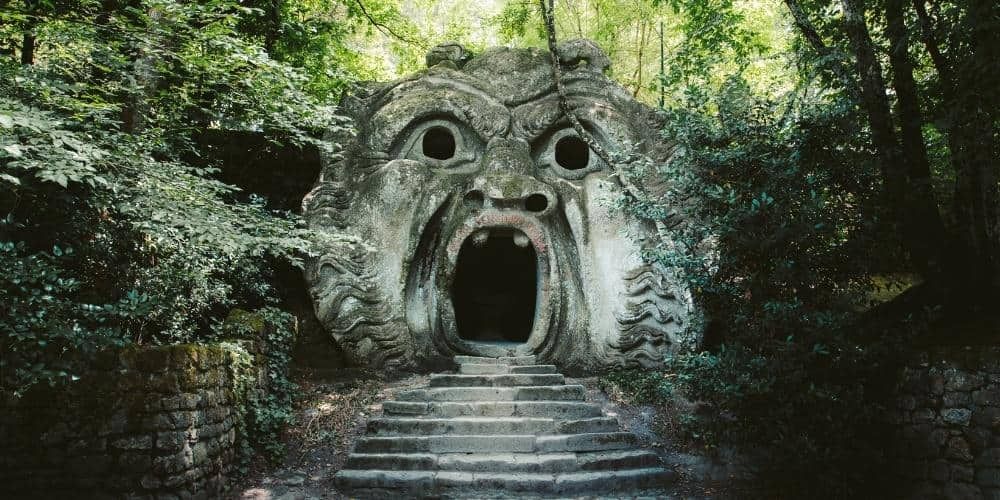
Nestled in the rural landscape of Viterbo, Bomarzo is located on a tuff hill in the heart of Tuscia, between the slopes of the Cimini Mountains and the Tiber Valley. This jewel of medieval urban planning is one of the most renowned historic centers of Lazio.
Its origins are shrouded in mystery; it was certainly an area intensely populated by both the Etruscans and the Romans, and in fact we can enjoy numerous testimonies of that time: Etruscan necropolises, ruins of an aqueduct, and above all the Etruscan Pyramid of Bomarzo, considered the largest rock monument in Europe.
Thanks to the Attigliano - Bomarzo station it is possible to easily reach this village from Rome, Montepulciano, Chiusi-Chianciano Terme, Orte and Naples. Times vary from half an hour to about two hours.
The path to discover the enchanted place passes through the fabulous Fosso Castello waterfalls, where the lush vegetation of moss and lichens envelops the tree trunks and makes the place enchanting. Through a tunnel you can then reach the Valle dei Mulini where you can observe the remains of the ancient buildings surrounded by a contemplative and relaxing silence.
After passing the Valley, the path leads uphill to a fantastic panoramic point, the Torre di Chia, from which you can observe the entire surrounding area. After taking an unforgettable photo, continue on your way to the Necropolis of Santa Cecilia. From here, crossing the anthropomorphic tuff tombs, you can reach the Pyramid of Bomarzo, also called “Sasso Del Predicatore”. It is an enormous trachytic boulder detached from the overlying volcanic wall, with 26 steps carved into the rock. It is impossible not to be amazed by this mighty eight-meter staircase, whose function, although not certain, was probably that of an altar for celebrations and sacrifices in the Etruscan era.
The most flourishing period of Bomarzo began when the village became a fief of the Orsini family, in the 16th century. Today you can admire the alleys and glimpses of astonishing beauty close to the Cathedral of Bomarzo and Palazzo Orsini. The latter was built in the Renaissance and was central to the affairs of the Roman nobility during the 16th century. Inside there is a beautiful hall frescoed by painters of the school of Pietro Da Cortona.
Palazzo Orsini is located inside the "Sacred Woods" today called the Park of Monsters. It is a real labyrinth in which to get lost as if in a magical world. Its large boulders with unknown meaning are famous, which stimulate intuition and imagination. Perfect if you love ancient legends and the adrenaline of mystery.
4. Cingoli: balcony of Marche
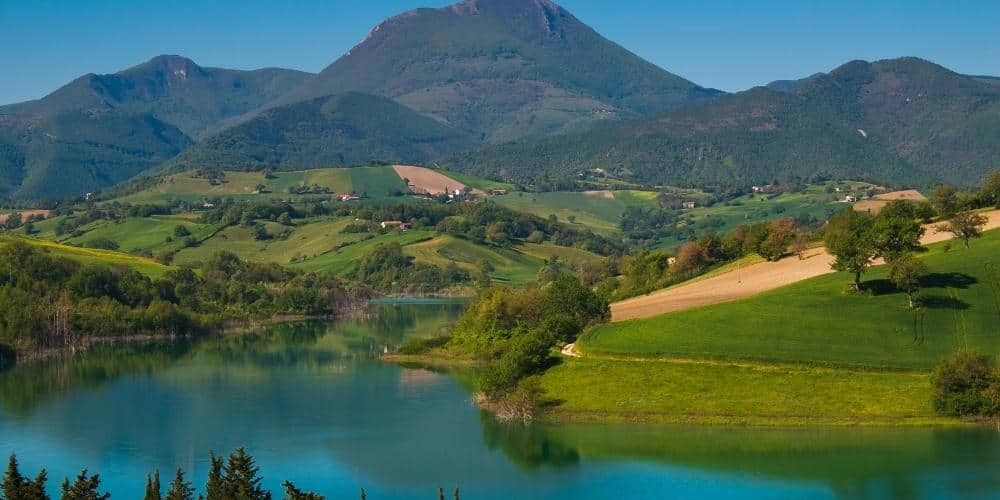
Via the Rome-Ancona railway line and a short bus ride from Jesi, we move to the Marche region, in the province of Macerata, to have our hair ruffled by the pleasant breeze that blows over the famous panoramic view of Cingoli.
From the medieval walls it is possible to look from the Adriatic Sea to the Umbrian-Marche Apennines. Cingoli is in fact perched on the top of Mount Circe. Due to its particularity, it is not only among the best places to visit in Italy without a car, but also obtained the title of Most Beautiful Villages in Italy.
Its origins are very ancient, dating back 5000 years. After several dominations, in 1829 Francesco Saverio Castiglioni became Pope with the name of Pius VIII and Cingoli became part of the Kingdom of Italy as a protagonist.
What immediately strikes you in the historic center is the sensation of time standing still in a harmonious calm that combines with the amazement of looking at the warm colors of the plaster of the facades, which frame elegant Renaissance portals.
Piazza Vittorio Emanuele II is the heart of Cingoli. Here stand the Cathedral of Santa Maria Assunta and the Town Hall, an ancient structure from the 12th century. Afterwards you can admire the beautiful noble Renaissance buildings, and then reach the square on which are the church of San Domenico and the convent of the order of Preachers which houses the canvas of the Madonna del Rosario e Santi, one of the most magnificent works of the restless Venetian painter Lorenzo Lotto.
Don't miss a walk through the neighborhoods of Polisena, the oldest in the city, with its small streets made of irregular stones and rustic houses, without plaster. Next to the former church of Santa Maria in Valverde is the beautiful Fontana di Maltempo and not far away is the seventeenth-century Palazzo Castiglioni, where Pope Pius VIII was born.
From Cingoli you can make interesting excursions into uncontaminated nature, for example to Lake Cingoli, ideal for getting in touch with yourself and the natural world.
3. Orta San Giulio and the Isle of Silence
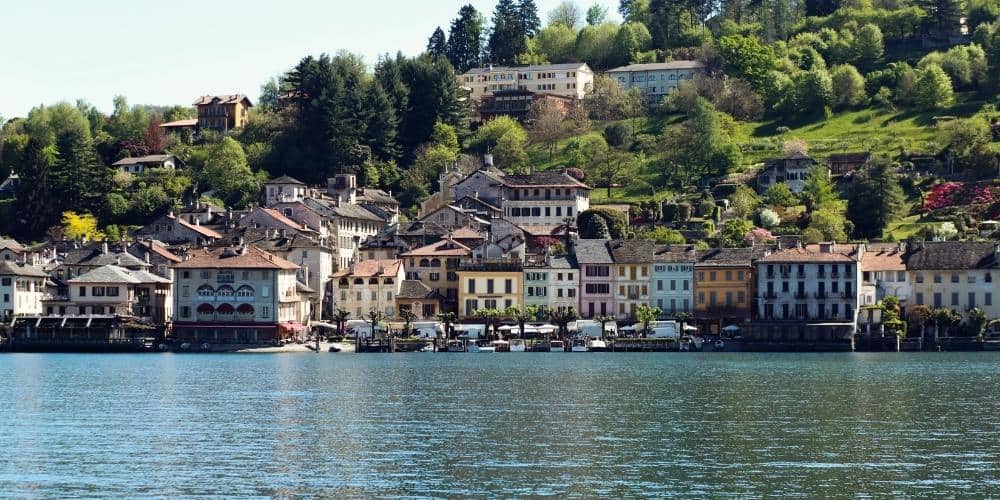
Let's fly now to Piedmont in another of the most beautiful villages in Italy: Orta San Giulio. After landing at Milan Malpensa Airport, it is easy to reach the village comfortably by train, thanks to the Novara - Domodossola line, with a stop at the Orta - Masino station.
Orta San Giulio has been awarded the Orange Flag by the Italian Touring Club, a recognition given to places that have distinguished themselves for hospitality and excellence in welcoming. A perfect destination to go to Italy without a car and find relaxation without smog and traffic.
Built on the shores of Lake Orta, the village takes its name from San Giulio who, according to legend, walking along the shores of the lake glimpsed a small island inhabited by snakes and dragons. Not finding a boat, he spread his cloak on the water and reached the island where he defeated the monsters and built the Basilica where he is still buried today.
In the village, architectural styles, from Romanesque to Baroque, mix. The narrow streets, characterized by silence and suggestive shadows, intersect and then descend on one side towards the lake. On the opposite side they lead to the Sacro Monte, a UNESCO World Heritage Site.
The center of Orta is Piazza Motta with the Palazzo della Comunità della Riviera di San Giulio. Here you can relax on the benches overlooking the lake, sipping a drink like in a real living room, or you can embark for the Island of San Giulio where the fascinating Romanesque Basilica of San Giulio will amaze you. Among the many villas to admire, Villa Tallone is of great importance and hosts wonderful classical music concerts every year.
The heart of the Island of San Giulio is the Benedictine Abbey Mater Ecclesiae. Here the nuns live in total silence. They are responsible for the mystical and contemplative atmosphere of the island and the Via del Silenzio, which leads to ancient villas, wells, walled gardens and narrow streets. The wrought iron plaques with maxims on meditation and silence add an aura of mystery and depth to this magical place.
2. In Trentino in the Valley of Harmony
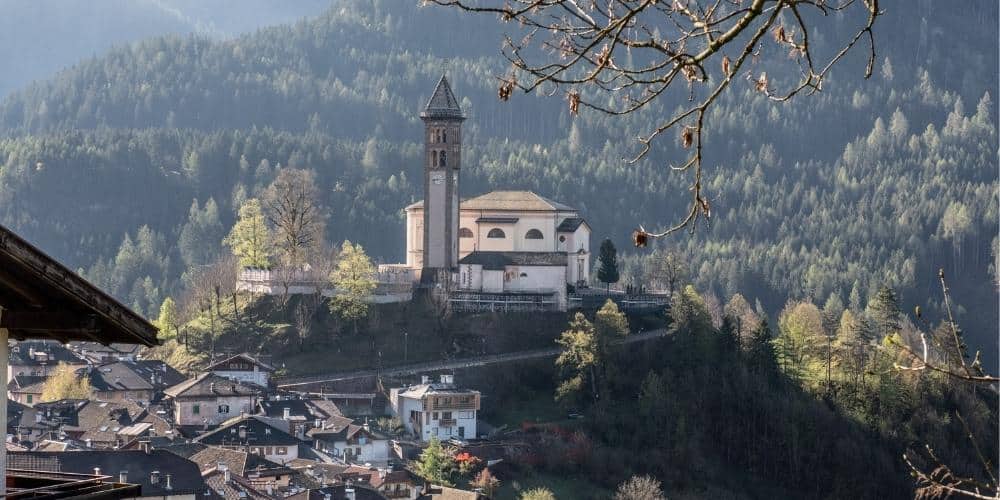
Our journey to discover the perfect places to visit in Italy without a car now takes us to Val di Fassa and Val di Fiemme, among the best landscapes in Trentino.
From the airports of Verona, Venice, Bergamo Orio Al Serio and Milan, you can take a “collective shuttle” and reach the Valle dell’Armonia. In the Panveggio Forest, in fact, you can find the most prized fir trees, with which the soundboards of violins are made.
It is said that even Stradivari expressed great appreciation for them, so much so that he wandered around the forest, also called the Forest of Violins, in search of centuries-old red firs, suitable for making perfect instruments. Today these soundboards are sought after all over the world and internationally renowned musicians still use the extraordinary red firs.
Valle di Fiemme is one of the main valleys of the Dolomites and extends along the Avisio torrent between the Lagorai and Latemar mountains. In addition to woods and forests, there are two natural parks and imposing peaks: the Corno Bianco, the Letemar Group with wonderful spires and the Pale di San Martino, all UNESCO Natural Heritage of Humanity.
A cycle path runs along it, from Molina di Fiemme to Moena, up to Canazei. Five ski areas and two cross-country skiing centers are available to sportsmen, while villages and towns await you if you want to learn about the history and traditions of this immense Italian paradise.
1. The Car-free Village
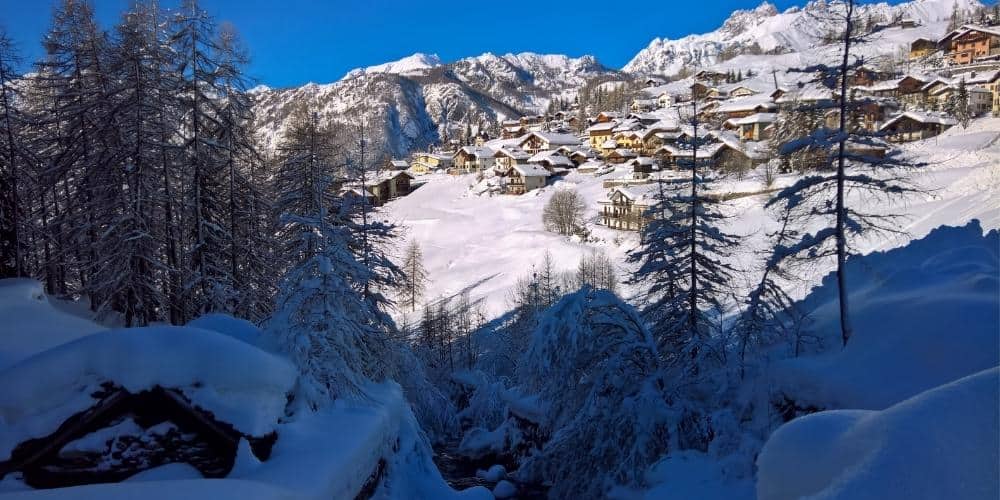
At the top of our top 5 places to go in Italy without a car, there is a village without smog, without noise, without stress: Chamois, not far from Aosta, is the only Italian municipality without cars.
A referendum in 1955 abolished the circulation of cars in this small enchanted place and now people move by bicycle, on horseback or on foot. A unique decision in Italy, of which even today, the inhabitants are proud, because it has made this village a place of serenity, peace and tranquility. Here there is only unspoiled nature, woods, immense mountains, magnificent expanses of meadows, many panoramic points and streets where the silence is broken only by the ringing of bells.
To arrive by train, get off at the Chatillon/Saint-Vincent station, here take the bus to Buisson which is the starting point of the cable car to go up to Chamois. Alternatively, the bravest can walk on the steep mule track that crosses the forest at an altitude of 700 meters.
This jewel of nature is divided into seven hamlets characterized by traditional, small houses made of wood and stone, surrounded by paths, lakes and streams, where farmers live off ancient activities as if time had stopped.
A two-hour walk from the center and at 700 meters above sea level, an unmissable panoramic point awaits you, Le Point Sublime. From here you can enjoy a stunning view of the Matterhorn or set off on ski descents or itineraries with "snowshoes", both in winter and in spring.
Fascinating and evocative, Lake Lord is one of the most characteristic corners. It is located at two thousand meters above sea level and can be reached by chairlift or on foot along simple paths.
In winter, this place transforms into a true paradise for ski lovers, especially for children who are taking their first steps in this activity.
About the author
Written on 17/12/2021



Marialuisa Monfreda
Are you in Italy with no car? Do you know the beauty of traveling at a slow pace? Here are the 5 best destinations in Italy to visit without a car.